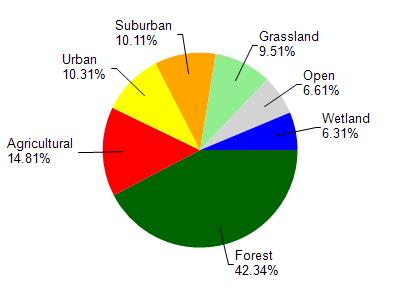La Crosse
No
No
No
Fish and Aquatic Life
Overview
Pammel Creek, located in southwest La Crosse County, flows for five miles in a westerly direction before reaching the Mississippi River on the south side of La Crosse. This stream has a gradient of 22 feet per mile. Pammel Creek is not a classified trout stream. Pammel Creek flows through some agricultural areas, an expanding rural home setting, a mobile home park, then through the southern portion of the City of La Crosse. Several subdivisions located on nearby hillsides drain their stormwater to Pammel Creek. Frequent flooding of homes adjacent to the creek precipitated a flood control project that resulted in a two mile long concrete lined ditch built in the late 1980's. Above and below the concrete channel, the stream bottom is comprised mainly of sand with small areas of gravel. Once the stream enters the concrete channel, the flow disperses across 15 feet of concrete to a maximum depth of a few inches during normal flow. Any accumulation of sediment in the concrete channel is regularly removed by the City of La Crosse. Due to the lack of habitat and shallow water in the channel, no fish are present. However, a forage fishery likely exists in the stream above the concrete channel and Mississippi River fish frequent the portion of Pammel Creek below the flood control channel.
Water chemistry testing of streams throughout La Crosse County was initiated by the La Crosse County Land Conservation Department in 1998. Baseflow conditions were targeted for testing as the most likely to show normal water quality conditions. Sampling takes place four times annually when no rainfall or snowmelt has occurred during the previous 72 hours. Between 1998 and 2001, Pammel Creek met the county phosphorus goal in nearly 80% and the county fecal coliform bacteria goal in nearly 75% of the samples taken. These data indicate relatively good water quality in Pammel Creek. The county ranks Pammel Creek very low in priority compared to other streams for efforts in reducing phosphorus and bacterial contamination. La Crosse County should continue baseflow sampling of Pammel Creek to determine water quality trends.
From: Koperski, Cindy. 2002. The State of the Bad Axe - La Crosse Basin. Wisconsin Department of Natural Resources, Madison, WI.
Date 2002
Author Cynthia Koperski
General Condition
Pammel Creek (WBIC 1649200) just east of Hagen Road to Unnamed Trib (WBIC 5027151) was assessed during the 2018 listing cycle; new biological (fish Index of Biotic Integrity (IBI) scores) sample data were clearly below the 2018 WisCALM listing thresholds for the Fish and Aquatic Life use. This water was meeting this designated use and was not considered impaired.
Date 2017
Author Ashley Beranek
Condition
Wisconsin has over 84,000 miles of streams, 15,000 lakes and milllions of acres of wetlands. Assessing the condition of this vast amount of water is challenging. The state's water monitoring program uses a media-based, cross-program approach to analyze water condition. An updated monitoring strategy (2015-2020) is now available. Compliance with Clean Water Act fishable, swimmable standards are located in the Executive Summary of Water Condition in 2018. See also the 'monitoring and projects' tab.
Reports
Recommendations
Monitor Aquatic Biology
Conduct biological (mIBI or fIBI) monitoring on Pammel Creek, WBIC: 1649200, AU:5721751
Management Goals
Wisconsin's Water Quality Standards provide qualitative and quantitative goals for waters that are protective of Fishable, Swimmable conditions [Learn more]. Waters that do not meet water quality standards are considered impaired and restoration actions are planned and carried out until the water is once again fishable and swimmable
Management goals can include creation or implementation of a Total Maximum Daily Load analysis, a Nine Key Element Plan, or other restoration work, education and outreach and more. If specific recommendations exist for this water, they will be displayed below online.
Monitoring
Monitoring the condition of a river, stream, or lake includes gathering physical, chemical, biological, and habitat data. Comprehensive studies often gather all these parameters in great detail, while lighter assessment events will involve sampling physical, chemical and biological data such as macroinvertebrates. Aquatic macroinvertebrates and fish communities integrate watershed or catchment condition, providing great insight into overall ecosystem health. Chemical and habitat parameters tell researchers more about human induced problems including contaminated runoff, point source dischargers, or habitat issues that foster or limit the potential of aquatic communities to thrive in a given area. Wisconsin's Water Monitoring Strategy was recenty updated.
Grants and Management Projects
Monitoring Projects
| WBIC | Official Waterbody Name | Station ID | Station Name | Earliest Fieldwork Date | Latest Fieldwork Date | View Station | View Data |
|---|
| 1649200 | Pammel Creek | 10016053 | Pammel Creek - 30 Yds Upstream Of Stonecrest Rd. | 10/11/2002 | 8/10/2011 | Map | Data |
|

Watershed Characteristics
Pammel Creek is located in the Lower La Crosse River watershed which is 145.46 mi². Land use in the watershed is primarily forest (42.30%), agricultural (14.80%) and a mix of urban (10.30%) and other uses (32.50%). This watershed has 295.20 stream miles, 1,187.12 lake acres and 5,641.64 wetland acres.
Nonpoint Source Characteristics
This watershed is ranked Medium for runoff impacts on streams, Not Ranked for runoff impacts on lakes and Low for runoff impacts on groundwater and therefore has an overall rank of Low. This value can be used in ranking the watershed or individual waterbodies for grant funding under state and county programs.However, all waters are affected by diffuse pollutant sources regardless of initial water quality. Applications for specific runoff projects under state or county grant programs may be pursued. For more information, go to surface water program grants.